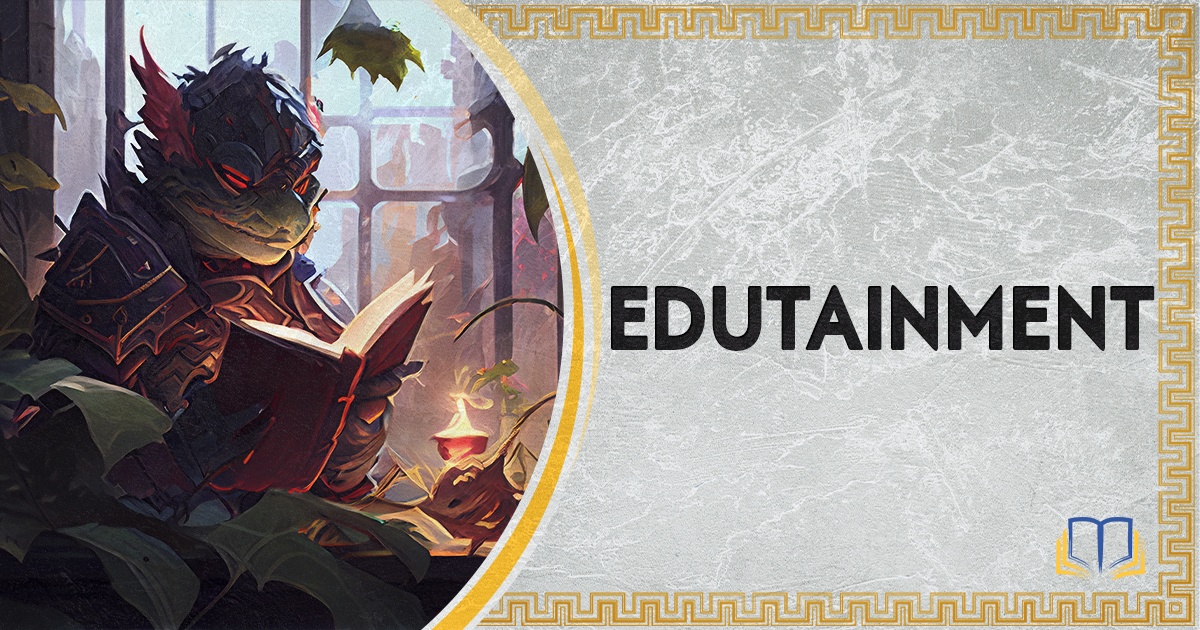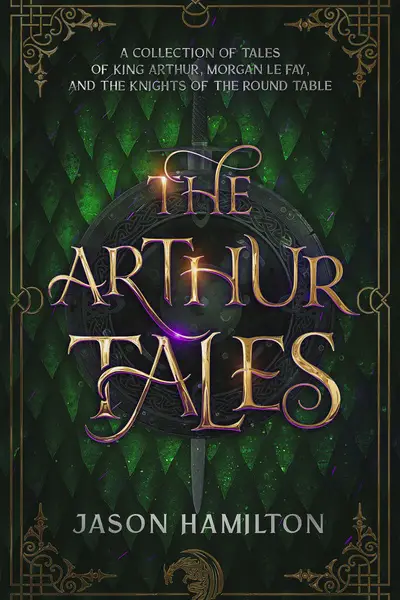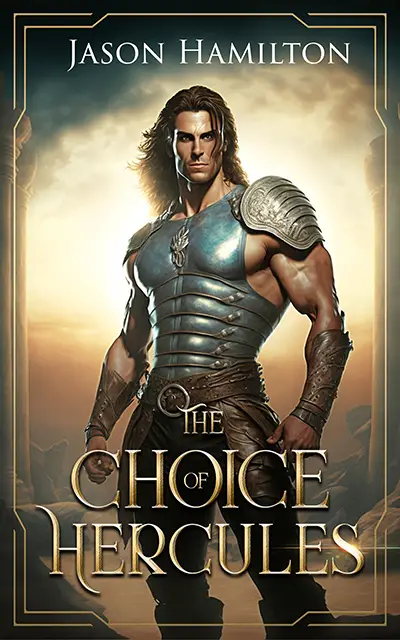Edutainment, the fusion of education and entertainment, has revolutionized the way we think about learning. By combining traditional educational content with engaging media like games, stories, and interactive exhibits, edutainment creates a more enjoyable and fulfilling learning experience.
In this article, I’ll explore the origins of edutainment, its benefits and effectiveness, and ways it can be implemented in various mediums like film, television, books, podcasts, toys, and theme parks.
Additionally, we’ll dive into my own personal experience with edutainment and how it inspired the creation of the Argoverse, a shared universe of myths and legends with an educational purpose.
But first, let’s definitively answer this question…
What Is Edutainment?
Edutainment is all about using entertainment to educate. It’s a creative approach that combines elements of traditional education with entertaining content, like games, stories, movies, and interactive media.
It’s a term that was coined back in the late 20th century, and it has transformed the way we think about education.
The idea is that if we can make learning enjoyable, people are more likely to retain the information they’re being taught.
And it’s not just about kids, either. Edutainment can be used to teach people of all ages, from toddlers to adults. In fact, I’ve personally experienced the power of edutainment in my own life, which is kind of what inspired this and other websites I’ve built.
So whether it’s a captivating YouTube video that teaches you a new skill, a mobile app that makes learning a language feel like a game, or an interactive exhibit at a museum that brings history to life, edutainment is all about tapping into our natural curiosity and love of storytelling to create memorable, educational experiences.
I, for one, am a huge fan.
Origins of Edutainment
Walt Disney was the first to coin the term “edutainment” in 1954, and it was later popularized by Robert Heyman in 1973 while producing documentaries for the National Geographic Society.
But long before the term was invented, the idea of merging education and entertainment was already in play. Notable historical periods like the Renaissance and Enlightenment emphasized the importance of using entertaining methods to teach and inspire.
Early Examples
One early example of edutainment is Benjamin Franklin’s Poor Richard’s Almanack.
Published in the 18th century, this work combined entertaining content like puzzles and witty sayings with practical advice and educational material.
Walt Disney
Walt Disney’s contributions to edutainment are significant. In 1922, he produced his first educational short film, Tommy Tucker’s Tooth, which was commissioned by the Deneer Dental Institute.
Over the years, Disney continued to merge education with entertainment, creating series like True-Life Adventures and Disneyland, which both delighted and educated audiences.
Uses in Health and Social Awareness
Since the 1970s, edutainment has been utilized to address a range of health and social issues, such as substance abuse, immunization, teenage pregnancy, HIV/AIDS, and cancer.
Major universities, NGOs, and government agencies, including Johns Hopkins Center for Communication Programs and the U.S. Centers for Disease Control (CDC), have developed and produced edutainment content to tackle these important topics.
Modern Uses
In today’s world, edutainment comes in many forms, from television productions and films to museum exhibits and computer software.
By incorporating educational content into traditionally recreational activities, edutainment continues to engage and enlighten audiences of all ages, making learning not just a necessity, but an enjoyable experience.
Benefits: Is Edutainment Effective?
Edutainment offers numerous advantages that make it a valuable tool for both educators and learners alike.
- Inspiring learners: By merging education with enjoyable content, edutainment can spark curiosity and a genuine interest in learning, making it a more enjoyable and fulfilling experience.
- Involve multiple senses: The ability to involve multiple senses through multimedia, which enhances engagement and promotes better information retention. By offering a more immersive learning experience, learners can absorb new concepts and knowledge more effectively.
- Enhancing learning experiences: By catering to different learning styles and preferences, edutainment creates a more inclusive and personalized educational environment, enabling learners to get the most out of their experiences.
- Resource efficiency: Edutainment often makes optimal use of available resources, creating a more cost-effective and sustainable approach to education.
- Improving job performance: In a corporate setting, edutainment can help employees better understand complex concepts and hone their skills, ultimately leading to improved performance on the job.
- Attracting millennials and Gen Z: With millennials and Gen-Z being a significant portion of the population, edutainment can be particularly appealing to this demographic, who often appreciate engaging and interactive learning experiences.
- Reduce short attention spans: By incorporating entertaining elements into the learning process, edutainment helps maintain the learners’ focus, making it easier for them to stay engaged and motivated.
Scientific Studies
There have been several studies proving the effectiveness of edutainment in classrooms. These include the following:
- Edutainment utilized in flipped classrooms, where students access video lessons and podcasts before attending class, has shown improvements in academic performance, greater in-class interaction, and increased enjoyment of lessons.
- Incorporating edutainment, like the TV show Numb3rs, in the training of future mathematics teachers has demonstrated the potential to enhance critical thinking, engagement, and growth mindsets.
- An edutainment-based mini-series designed for pharmacy preceptors effectively boosted their confidence and was acknowledged by the American Association of Colleges of Pharmacy.
- Employing edutainment in the form of games for disabled students has revealed positive effects on their scores, coordination, communication, and memory skills.
Applications: Ways to Create and Use Edutainment
So we understand what Edutainment is, and why it can benefit us, but what are some ways we can see it being used (or we can use ourselves) in the creation and utilization of media.
Hopefully the following can give you some ideas…
Film/Television
Edutainment has played a significant role in the film and television industry, dating back to the early 1940s. It offers a unique combination of education and entertainment, appealing to a wide range of audiences.
TV programs can be categorized in three ways:
- Those primarily focused on education
- Those balancing education and entertainment
- Entertainment shows with occasional educational value
A notable example of edutainment is the “Sabido method,” introduced by Mexican TV producer Miguel Sabido in the 1970s through telenovelas, which led to social change in various countries.
Another example is MTV Shuga, a show aimed at educating African youth about sexual health and HIV, with measurable effects on viewers’ actions.
For creators interested in incorporating edutainment into film and television, it’s essential to find a balance between engaging storytelling and educational content. By making learning enjoyable and relatable, creators can effectively communicate essential messages and promote social change.
They can use various formats, such as documentaries, dramas, and even reality shows, to deliver educational content in a captivating way. By understanding the target audience and addressing their needs, creators can develop compelling stories that resonate with viewers and leave a lasting impact on their understanding of critical issues.
Educational Games
Games and gamification offer valuable opportunities for edutainment, combining entertainment with educational content to create engaging and effective learning experiences.
There are various types of games, including:
- Board games
- Card games
- Quizzes
- Video games,
All of these can be used for educational purposes, either explicitly designed for learning or with incidental educational value.
There are two main ways in which games and gamification can be used for edutainment:
Gamification involves adding elements of friendly competition to the learning experience, such as points, badges, levels, or leaderboards. This approach motivates learners, encouraging them to develop winning strategies, solve problems, and work collaboratively.
Game-based learning goes beyond gamification, with the entire learning experience structured as a game. Learners develop knowledge by progressing through the game, absorbing new information on the topic. Designing games for edutainment requires aligning the game with learning objectives and basing game rules on performance criteria.
Creators can leverage games and gamification to enhance learner autonomy and provide a risk-free environment for learning. Games teach logical reasoning and decision-making, boosting employee efficiency and confidence at work.
To successfully implement games and gamification in edutainment, creators should ensure the learning objectives are clear, the game rules are based on performance criteria, and the game itself is engaging and enjoyable.
Augmented/Virtual Reality
Though technically considered a close relative of gaming, Augmented reality (AR) and virtual reality (VR) technologies have the potential to revolutionize edutainment by providing immersive and engaging learning environments suitable for multiple forms training.
Not just in the classroom, but potentially in business and at-home games as well.
VR simulations offer employees hands-on learning experiences that are both effective and risk-free. These technologies enable learners to interact with realistic scenarios, improving their understanding and retention of the subject matter.
As businesses consider incorporating edutainment into their training programs, they must evaluate the necessary technology to implement AR and VR experiences effectively. The right tools and platforms can significantly enhance the learning process and boost employee performance.
Educational Books
Storytelling and educational books are powerful tools for edutainment, as they can captivate audiences while imparting knowledge.
Creators can leverage these mediums by crafting compelling narratives that weave educational content into engaging stories.
This approach not only makes learning enjoyable but also helps readers retain information better.
To successfully use storytelling for edutainment, creators should focus on developing relatable characters, intriguing plots, and immersive settings.
Integrating facts, concepts, or lessons seamlessly into the story will ensure that readers absorb the educational content without feeling overwhelmed or disinterested.
Common genres where we see this happen include:
- Middle-grade Books
- Hard Science Fiction
- Historical Fiction
- Historical Fantasy
However, you can find educational elements in almost any genre, depending on what knowledge is being taught.
In educational books, authors can use vibrant illustrations, quizzes, exercises, and discussion questions, can also be incorporated to reinforce learning and encourage readers to actively engage with the material.
Additionally, creators can develop multimedia resources, like audiobooks or animated videos, to cater to different learning styles and preferences.
This is basically what I’m trying to do with MythBank and the books I write. But more on that later…
Radio/Podcasting
Radio and podcasts can be highly effective mediums for edutainment, blending education and entertainment to engage audiences on various topics.
Creators can use these platforms to deliver valuable information in a conversational and captivating manner.
Examples:
- Radio shows like The Archers and Twende na Wakati have educated their audiences on agriculture and family planning, respectively.
- Podcasts such as Serial, Freakonomics Radio, Invisibilia, RadioLab, Science Friday, Stuff You Should Know, and TED Radio Hour cover diverse topics while maintaining an engaging and informative tone.
In addition to catering to recreational listeners, podcasts can also be used as educational tools in various settings. Lessons based on podcasts have grown in popularity, with platforms like TeachersPayTeachers witnessing a significant rise in lesson plan downloads related to podcasts.
To use radio or podcasts for edutainment, creators should focus on selecting compelling topics, employing conversational tones, and presenting information in an appealing way.
The content should be designed to captivate listeners while seamlessly incorporating educational elements.
Creators can leverage the power of storytelling and relatable examples to make complex subjects more accessible and enjoyable for the audience.
Toys
Toys are among the earliest edutainment tools that children encounter, teaching them literacy, numerical, conceptual, or motor skills. These educational toys can range from colorful, scaled-down versions of complex objects to construction toys like Legos, which help develop creativity, motor skills, reasoning, and spatial recognition.
Toys like Lego and Rubik’s Cube can appeal to both children and adults, with their design and implementation ranging from simple to sophisticated.
Teachers can incorporate toys into their lessons to add a hands-on component, making subjects like architecture, fine art, robotics, engineering, history, and government more engaging and interactive.
Creators can develop edutainment toys by focusing on promoting learning through play.
By designing toys that stimulate children’s curiosity and facilitate the development of various skills, creators can ensure that their products serve educational purposes while still being engaging and fun.
Hip-hop Culture
Edutainment, has become associated with hip hop culture’s ability to educate through its unique combination of thought and action.
Hip Hop has been uniquely suited for edutainment, combining bought thought and action, and the way that Hip Hop is able to transmit technical and historical knowledge through the collaborative moments of performance.
For example, the musical Hamilton utilizes hip hop to teach about the American Revolution by incorporating its pedagogical aesthetics.
By leveraging the power of hip hop culture, Hamilton has successfully transformed history education into an entertaining and immersive experience.
Theme Parks
Theme parks often combine entertainment and education, providing engaging experiences for visitors.
Epcot at Walt Disney World is a prime example, with attractions focused on the past, conservation, imagination, future technologies, and global cultures.
SeaWorld increasingly emphasizes marine biology, conservation, and animal rescue efforts in response to animal rights activism.
Other theme parks that incorporate educational elements include Disney’s Animal Kingdom, Holy Land Experience, Dinosaur World, Busch Gardens, and Puy du Fou.
These parks successfully blend amusement with learning opportunities, offering unique experiences that both entertain and inform visitors.
Museums
Edutainment is gaining traction in science centers, children’s museums, zoos, and botanical gardens, as these institutions seek innovative ways to engage the public in arts, science, literature, and history.
To meet the demand for flashy, polished experiences, museums implement interactive elements, games, and mobile apps to enhance learning.
Edutainment and the Argoverse
So why am I even writing this article? Partly because Edutainment is incredibly inspiring to me, and is even part of my mission for this site.
But also because I am a fantasy author and love to write books that specifically have an educational purpose.
I was particularly inspired by Rick Riordan and his Percy Jackson series, which has done a lot for educating young kids about mythology, one of my loves (obviously).
That’s why I created the Argoverse, a shared universe of myths and legends, where I do my best to incorporate ALL mythologies into one universe.
The best place to start delving into this Argoverse it to look at some of my free short stories.
The two I most recommend are:
The Arthur Tales: several short stories set in Arthurian Britain. It includes my version of the Sword in the Stone story.
The Choice of Hercules: A quick story I wrote adapting my favorite story about Hercules, which also has some really great self-help applications.
I hope you enjoy!





